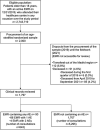Is primary care a patient-safe setting? Prevalence, severity, nature, and causes of adverse events: numerous and mostly avoidable
- PMID: 37043330
- PMCID: PMC10148678
- DOI: 10.1093/intqhc/mzad019
Is primary care a patient-safe setting? Prevalence, severity, nature, and causes of adverse events: numerous and mostly avoidable
Erratum in
-
Correction to: Is primary care a patient-safe setting? Prevalence, severity, nature, and causes of adverse events: numerous and mostly avoidable.Int J Qual Health Care. 2023 May 25;35(2):mzad033. doi: 10.1093/intqhc/mzad033. Int J Qual Health Care. 2023. PMID: 37227934 Free PMC article. No abstract available.
Abstract
Knowing the frequency and characteristics of adverse events (AEs) is key to implementing actions that can prevent their occurrence. However, reporting systems are insufficient for this purpose and epidemiological studies are also required. Currently, the reviewing of clinical records is the gold standard method for knowing the frequency and characteristics of AEs. Research on AEs in a primary care setting has been limited and primarily focuses on specific types of events (medication errors, etc.) or patients. Large studies that search for any kind of AE in all patients are scarce. This study aimed to estimate the prevalence of AEs in the primary care setting and their characteristics.
Setting: all 262 primary health-care centres in the Madrid region (Spain) during the last quarter of 2018.
Design: cross-sectional descriptive study. Eligible population: subjects over 18 years of age who attended medical consultation over the last year (N = 2 743 719); a randomized sample stratified by age.
Main outcomes: age, sex, occurrence of an AE, number of consultations in the study period, avoidability, severity, place of occurrence, type of event, and contributory factors. The clinical records were reviewed by three teams, each composed of one doctor and one nurse trained and with expertise in patient safety. The SPSS software package (version 26) was used for the statistical analyses. The evaluators reviewed 1797 clinical records. The prevalence of AEs over the study period was 5.0% [95% confidence interval (CI): 4.0%‒6.0%], with higher values in women (5.7%; 95% CI: 4.6%‒6.8%;P = 0.10) and patients over 75 years of age (10.3%; 95% CI: 8.9%‒11.7%; P < 0.001). The overall occurrence per hundred consultations was estimated to be 1.58% (95% CI: 1.28%‒1.94%). Of the detected AEs, 71.3% (95% CI: 62.1%‒80.5%) were avoidable. Additionally, 60.6% (95% CI: 50.7%‒70.5%) were categorized as mild, 31.9% (95% CI: 22.4%‒41.4%) as moderate, and 7.4% (95% CI: 2.1%‒12.7%) as severe. Primary care was the occurrence setting in 76.6% (95% CI: 68.0%‒85.2%) of cases. The overall incidence of AEs related to medication was 53.2% (95% CI: 50.9%‒55.5%). The most frequent types of AEs were prescription errors (28.7%; 95% CI: 19.5%‒37.9%), followed by drug administration errors by patients (17.0%; 95% CI: 9.4%‒24.6%), and clinical assessment errors (11.7%; 95% CI: 5.2%‒18.2%). The most common contributory factors were those related to the patient (80.6%; 95% CI: 71.1%‒90.1%) and tasks (59.7%; 95% CI: 48.0%‒71.4%). A high prevalence of AEs (1 in 66 consultations) was observed, which was slightly higher than that reported in similar studies. About 3 out of 4 such events were considered to be avoidable and 1 out of 13 was severe. Prescription errors, drug administration errors by patients, and clinical assessment errors were the most frequent types of AEs. Graphical Abstract.
Keywords: medical errors; patient harm; patient safety; prevalence; primary health care; ‘adverse events’.
© The Author(s) 2023. Published by Oxford University Press on behalf of International Society for Quality in Health Care.
Similar articles
-
Validation of a Reduced Set of High-Performance Triggers for Identifying Patient Safety Incidents with Harm in Primary Care: TriggerPrim Project.J Patient Saf. 2023 Dec 1;19(8):508-516. doi: 10.1097/PTS.0000000000001161. Epub 2023 Sep 14. J Patient Saf. 2023. PMID: 37707868 Free PMC article.
-
Post-pandemic patient safety: have the characteristics of incidents with harm changed? Comparative observational study in primary care via review of medical records with a trigger tool.BMC Prim Care. 2024 Nov 7;25(1):392. doi: 10.1186/s12875-024-02639-3. BMC Prim Care. 2024. PMID: 39511497 Free PMC article.
-
Adverse events: an expensive and avoidable hospital problem.Ann Med. 2022 Dec;54(1):3157-3168. doi: 10.1080/07853890.2022.2140450. Ann Med. 2022. PMID: 36369717 Free PMC article.
-
Single-dose intravenous ketorolac for acute postoperative pain in adults.Cochrane Database Syst Rev. 2021 May 17;5(5):CD013263. doi: 10.1002/14651858.CD013263.pub2. Cochrane Database Syst Rev. 2021. PMID: 33998669 Free PMC article.
-
The occurrence, types, consequences and preventability of in-hospital adverse events - a scoping review.BMC Health Serv Res. 2018 Jul 4;18(1):521. doi: 10.1186/s12913-018-3335-z. BMC Health Serv Res. 2018. PMID: 29973258 Free PMC article.
Cited by
-
Patient and family engagement interventions in primary care patient safety: systematic review and meta-analysis of randomised controlled trials.Br J Gen Pract. 2025 Jun 26;75(756):e491-e499. doi: 10.3399/BJGP.2024.0369. Print 2025 Jul. Br J Gen Pract. 2025. PMID: 40355248 Free PMC article.
-
Validation of a Reduced Set of High-Performance Triggers for Identifying Patient Safety Incidents with Harm in Primary Care: TriggerPrim Project.J Patient Saf. 2023 Dec 1;19(8):508-516. doi: 10.1097/PTS.0000000000001161. Epub 2023 Sep 14. J Patient Saf. 2023. PMID: 37707868 Free PMC article.
-
Post-pandemic patient safety: have the characteristics of incidents with harm changed? Comparative observational study in primary care via review of medical records with a trigger tool.BMC Prim Care. 2024 Nov 7;25(1):392. doi: 10.1186/s12875-024-02639-3. BMC Prim Care. 2024. PMID: 39511497 Free PMC article.
References
-
- World Health Organization & WHO Patient Safety . Conceptual framework for the international classification for patient safety (version 1.1: final technical report January 2009). World Health Organization. https://apps.who.int/iris/handle/10665/70882 (Jun 2022, date last accessed).


